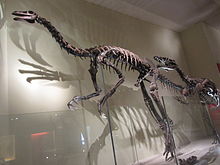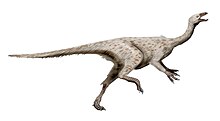Beishanlong: Difference between revisions
taxobox cleanup |
m discontinued portal |
||
| (23 intermediate revisions by 19 users not shown) | |||
| Line 1: | Line 1: | ||
{{Short description|Extinct genus of dinosaurs}} |
|||
{{speciesbox |
{{speciesbox |
||
| fossil_range = |
| fossil_range = Late Aptian, {{fossil range|123|113}} |
||
| image = Skeleton of Beishanlong grandis.JPG |
| image = Skeleton of Beishanlong grandis.JPG |
||
| image_caption = Restored skeleton of ''Beishanlong'' and ''[[Xiongguanlong]]'' |
| image_caption = Restored skeleton of ''Beishanlong'' and ''[[Xiongguanlong]]'' |
||
| Line 10: | Line 11: | ||
}} |
}} |
||
'''''Beishanlong''''' is a [[genus]] of giant [[ornithomimosauria]]n [[theropod]] [[dinosaur]] from the [[Early Cretaceous]] of [[China]]. |
'''''Beishanlong''''' is a [[genus]] of giant [[ornithomimosauria]]n [[theropod]] [[dinosaur]] from the [[Early Cretaceous]] of [[China]]. It is the second-largest ornithomimosaur discovered, only surpassed by ''[[Deinocheirus]].'' |
||
==Discovery and naming== |
==Discovery and naming== |
||
[[File:Beishanlong grandis.jpg|thumb|left|Restoration]] |
[[File:Beishanlong grandis.jpg|thumb|left|Restoration]] |
||
Three fossils of ''Beishanlong'' were in the early twenty-first century found in northwestern China at the ''White Ghost Castle'' site, in the province of [[Gansu]]. The [[type species]] is ''Beishanlong grandis'', described and named online in 2009 by a team of Chinese and American paleontologists, and formally published in January [[2010 in paleontology|2010]] by the same [[Peter Makovicky]], [[Li Daiqing]], [[Gao Keqin]], [[Matthew Lewin]], [[Gregory Erickson]] and [[Mark Norrell]]. The generic name combines a references to the [[Bei Shan]], the " |
Three fossils of ''Beishanlong'' were in the early twenty-first century found in northwestern China at the ''White Ghost Castle'' site, in the province of [[Gansu]]. The [[type species]] is ''Beishanlong grandis'', described and named online in 2009 by a team of Chinese and American paleontologists, and formally published in January [[2010 in paleontology|2010]] by the same [[Peter Makovicky]], [[Li Daiqing]], [[Gao Keqin]], [[Matthew Lewin]], [[Gregory Erickson]] and [[Mark Norrell]]. The generic name combines a references to the [[Bei Shan]], the "North Mountains", with a Chinese ''long'', "dragon". The [[specific name (zoology)|specific name]] means "large" in [[Latin]], in reference to the body size.<ref name="Makovickyetal"/> |
||
''Beishanlong'' lived |
''Beishanlong'' lived in the late Aptian<ref>{{Cite journal |last1=Suarez |first1=Marina B. |last2=Milder |first2=Timothy |last3=Peng |first3=Nan |last4=Suarez |first4=Celina A. |last5=You |first5=Hailu |last6=Li |first6=Daqing |last7=Dodson |first7=Peter |date=2018-12-13 |title=Chemostratigraphy of the Lower Cretaceous dinosaur-bearing Xiagou and Zhonggou formations, Yujingzi Basin, northwest China |journal=Journal of Vertebrate Paleontology |volume=38 |issue=sup1 |pages=12–21 |doi=10.1080/02724634.2018.1510412 |s2cid=202865132 |issn=0272-4634}}</ref> stage, with its fossils being uncovered in layers of the [[Xinminpu Group]], in the [[Xiagou Formation]]. The [[holotype]] is '''FRDC-GS GJ (06) 01-18''', found in 2006, consisting of a partial skeleton lacking the skull.<ref name="Makovickyetal"/> The [[paratype]]s consist of two specimens found in 2007: one consisting of remains of hindlimbs, the other, FRDC-GS JB(07)01-01, being a pair of [[Pubis (bone)|pubes]]. A fourth fossil found in 1999, IVPP V12756 consisting of foot bones, was tentatively referred to the species.<ref name="Makovickyetal"/> |
||
==Description== |
==Description== |
||
[[File:Beishanlong Scale.svg|thumb|left|Size comparison]] |
|||
''Beishanlong'' is of a considerable size, approximating the largest known individuals of ''[[Gallimimus]]'', which have been estimated to reach eight metres. According to the description, ''Beishanlong'' "is one of the largest definitive ornithomimosaurs yet described, though histological analysis shows that the holotype individual was still growing at its death." Extrapolating from the sixty-six centimetres long thighbone, the describers estimated the weight at 626 kilogrammes.<ref name="Makovickyetal"/> [[Gregory S. Paul]] in 2010 gave an estimate of seven metres length and five hundred fifty kilogrammes.<ref>Paul, G.S., 2010, ''The Princeton Field Guide to Dinosaurs'', Princeton University Press p. 112</ref> A [[histology|histological]] study of the bone structure of the [[fibula]] found thirteen or fourteen growth lines, indicating the individual was subadult, though growth had already slowed.<ref name="Makovickyetal"/> |
|||
''Beishanlong'' is of a considerable size, approximating the largest-known individuals of ''[[Gallimimus]]'', which have been estimated to reach eight metres. According to the description, ''Beishanlong'' "is one of the largest definitive ornithomimosaurs yet described, though histological analysis shows that the holotype individual was still growing at its death." A [[histology|histological]] study of the bone structure of the [[fibula]] found thirteen or fourteen growth lines, indicating the individual was subadult, though growth had already slowed.<ref name="Makovickyetal"/> The size of this subadult individual is estimated at {{cvt|5.9|-|7|m|ft}} in length and {{convert|375|-|626|kg|lbs}} in body mass.<ref>Paul, G.S., 2010, ''The Princeton Field Guide to Dinosaurs'', Princeton University Press p. 112</ref><ref name="Makovickyetal"/><ref>{{cite journal|author1=Claudia Inés Serrano-Brañas|author2=Belinda Espinosa-Chávez|author3=S. Augusta Maccracken|author4=Cirene Gutiérrez-Blando|author5=Claudio de León-Dávila|author6=José Flores Ventura|year=2020|title=''Paraxenisaurus normalensis'', a large deinocheirid ornithomimosaur from the Cerro del Pueblo Formation (Upper Cretaceous), Coahuila, Mexico|journal=Journal of South American Earth Sciences|volume=101|pages=Article 102610|doi=10.1016/j.jsames.2020.102610}}</ref><ref>{{Cite journal |last1=Chinzorig |first1=Tsogtbaatar |last2=Cullen |first2=Thomas |last3=Phillips |first3=George |last4=Rolke |first4=Richard |last5=Zanno |first5=Lindsay E. |date=2022-10-19 |title=Large-bodied ornithomimosaurs inhabited Appalachia during the Late Cretaceous of North America |journal=PLOS One |volume=17 |issue=10 |at=e0266648 |doi=10.1371/journal.pone.0266648 |doi-access=free |pmc=9581415 }}</ref> |
|||
The build of ''Beishanlong'' was rather robust. The arms and legs were long, though lacking the extremely elongated hands, feet and claws of later forms.<ref name="Makovickyetal"/> |
The build of ''Beishanlong'' was rather robust. The arms and legs were long, though lacking the extremely elongated hands, feet and claws of later forms.<ref name="Makovickyetal"/> |
||
==Classification== |
==Classification== |
||
''Beishanlong'' was by the describers assigned to the [[Ornithomimosauria]], in a more basal position. ''Beishanlong'' was closely related to fellow ornithomimosaurian ''[[Harpymimus]]''. Together they formed a [[polytomy]] with the main ornithomimosaurian branch just below ''[[Garudimimus]]''.<ref name="Makovickyetal">{{cite journal | last1 = Makovicky | first1 = Peter J. | last2 = Li | first2 = Daqing | last3 = Gao | first3 = Ke-Qin | last4 = Lewin | first4 = Matthew | last5 = Erickson | first5 = Gregory M. | last6 = Norell | first6 = Mark A. | year = 2010 | title = A giant ornithomimosaur from the Early Cretaceous of China |
''Beishanlong'' was by the describers assigned to the [[Ornithomimosauria]], in a more [[Basal (phylogenetics)|basal]] position. ''Beishanlong'' was closely related to fellow ornithomimosaurian ''[[Harpymimus]]''. Together they formed a [[polytomy]] with the main ornithomimosaurian branch just below ''[[Garudimimus]]''.<ref name="Makovickyetal">{{cite journal | last1 = Makovicky | first1 = Peter J. | last2 = Li | first2 = Daqing | last3 = Gao | first3 = Ke-Qin | last4 = Lewin | first4 = Matthew | last5 = Erickson | first5 = Gregory M. | last6 = Norell | first6 = Mark A. | year = 2010 | title = A giant ornithomimosaur from the Early Cretaceous of China | journal = Proceedings of the Royal Society B: Biological Sciences | volume = 277 | issue = 1679| pages = 191–198 | doi = 10.1098/rspb.2009.0236 | pmid=19386658 | pmc=2842665}}</ref> In 2014 Yuong-Nam Lee ''et al.'' recovered ''Beishanlong'' as a member of [[Deinocheiridae]] basal to a [[clade]] containing ''Garudimimus'' and ''[[Deinocheirus]]''.<ref name="leeetal2014">Yuong-Nam Lee, Rinchen Barsbold, Philip J. Currie, Yoshitsugu Kobayashi, Hang-Jae Lee, Pascal Godefroit, François Escuillié & Tsogtbaatar Chinzorig (2014) "Resolving the long-standing enigmas of a giant ornithomimosaur ''Deinocheirus mirificus''". ''Nature'' (advance online publication) {{doi|10.1038/nature13874}}.</ref> |
||
==See also== |
==See also== |
||
| ⚫ | |||
* [[Timeline of ornithomimosaur research]] |
* [[Timeline of ornithomimosaur research]] |
||
| Line 34: | Line 35: | ||
==External links== |
==External links== |
||
* [http://www.sciencecentric.com/news/article.php?q=09042245-field-museum-palaeontologist-leads-study-on-two-new-dinosaurs-from-china "Field Museum palaeontologist leads study on two new dinosaurs from China"] |
* [https://archive.today/20121208233054/http://www.sciencecentric.com/news/article.php?q=09042245-field-museum-palaeontologist-leads-study-on-two-new-dinosaurs-from-china "Field Museum palaeontologist leads study on two new dinosaurs from China"] ScienceCentric.com |
||
{{Theropoda|O.}} |
|||
{{Taxonbar|from1=Q18578494|from2=Q1442152}} |
|||
| ⚫ | |||
[[Category:Early Cretaceous dinosaurs of Asia]] |
[[Category:Early Cretaceous dinosaurs of Asia]] |
||
Revision as of 18:33, 10 February 2024
| Beishanlong Temporal range: Late Aptian,
| |
|---|---|

| |
| Restored skeleton of Beishanlong and Xiongguanlong | |
| Scientific classification | |
| Domain: | Eukaryota |
| Kingdom: | Animalia |
| Phylum: | Chordata |
| Clade: | Dinosauria |
| Clade: | Saurischia |
| Clade: | Theropoda |
| Clade: | †Ornithomimosauria |
| Family: | †Deinocheiridae |
| Genus: | †Beishanlong Makovicky et al., 2010 |
| Species: | †B. grandis
|
| Binomial name | |
| †Beishanlong grandis Makovicky et al., 2010
| |
Beishanlong is a genus of giant ornithomimosaurian theropod dinosaur from the Early Cretaceous of China. It is the second-largest ornithomimosaur discovered, only surpassed by Deinocheirus.
Discovery and naming

Three fossils of Beishanlong were in the early twenty-first century found in northwestern China at the White Ghost Castle site, in the province of Gansu. The type species is Beishanlong grandis, described and named online in 2009 by a team of Chinese and American paleontologists, and formally published in January 2010 by the same Peter Makovicky, Li Daiqing, Gao Keqin, Matthew Lewin, Gregory Erickson and Mark Norrell. The generic name combines a references to the Bei Shan, the "North Mountains", with a Chinese long, "dragon". The specific name means "large" in Latin, in reference to the body size.[1]
Beishanlong lived in the late Aptian[2] stage, with its fossils being uncovered in layers of the Xinminpu Group, in the Xiagou Formation. The holotype is FRDC-GS GJ (06) 01-18, found in 2006, consisting of a partial skeleton lacking the skull.[1] The paratypes consist of two specimens found in 2007: one consisting of remains of hindlimbs, the other, FRDC-GS JB(07)01-01, being a pair of pubes. A fourth fossil found in 1999, IVPP V12756 consisting of foot bones, was tentatively referred to the species.[1]
Description

Beishanlong is of a considerable size, approximating the largest-known individuals of Gallimimus, which have been estimated to reach eight metres. According to the description, Beishanlong "is one of the largest definitive ornithomimosaurs yet described, though histological analysis shows that the holotype individual was still growing at its death." A histological study of the bone structure of the fibula found thirteen or fourteen growth lines, indicating the individual was subadult, though growth had already slowed.[1] The size of this subadult individual is estimated at 5.9–7 m (19–23 ft) in length and 375–626 kilograms (827–1,380 lb) in body mass.[3][1][4][5]
The build of Beishanlong was rather robust. The arms and legs were long, though lacking the extremely elongated hands, feet and claws of later forms.[1]
Classification
Beishanlong was by the describers assigned to the Ornithomimosauria, in a more basal position. Beishanlong was closely related to fellow ornithomimosaurian Harpymimus. Together they formed a polytomy with the main ornithomimosaurian branch just below Garudimimus.[1] In 2014 Yuong-Nam Lee et al. recovered Beishanlong as a member of Deinocheiridae basal to a clade containing Garudimimus and Deinocheirus.[6]
See also
References
- ^ a b c d e f g Makovicky, Peter J.; Li, Daqing; Gao, Ke-Qin; Lewin, Matthew; Erickson, Gregory M.; Norell, Mark A. (2010). "A giant ornithomimosaur from the Early Cretaceous of China". Proceedings of the Royal Society B: Biological Sciences. 277 (1679): 191–198. doi:10.1098/rspb.2009.0236. PMC 2842665. PMID 19386658.
- ^ Suarez, Marina B.; Milder, Timothy; Peng, Nan; Suarez, Celina A.; You, Hailu; Li, Daqing; Dodson, Peter (2018-12-13). "Chemostratigraphy of the Lower Cretaceous dinosaur-bearing Xiagou and Zhonggou formations, Yujingzi Basin, northwest China". Journal of Vertebrate Paleontology. 38 (sup1): 12–21. doi:10.1080/02724634.2018.1510412. ISSN 0272-4634. S2CID 202865132.
- ^ Paul, G.S., 2010, The Princeton Field Guide to Dinosaurs, Princeton University Press p. 112
- ^ Claudia Inés Serrano-Brañas; Belinda Espinosa-Chávez; S. Augusta Maccracken; Cirene Gutiérrez-Blando; Claudio de León-Dávila; José Flores Ventura (2020). "Paraxenisaurus normalensis, a large deinocheirid ornithomimosaur from the Cerro del Pueblo Formation (Upper Cretaceous), Coahuila, Mexico". Journal of South American Earth Sciences. 101: Article 102610. doi:10.1016/j.jsames.2020.102610.
- ^ Chinzorig, Tsogtbaatar; Cullen, Thomas; Phillips, George; Rolke, Richard; Zanno, Lindsay E. (2022-10-19). "Large-bodied ornithomimosaurs inhabited Appalachia during the Late Cretaceous of North America". PLOS One. 17 (10). e0266648. doi:10.1371/journal.pone.0266648. PMC 9581415.
- ^ Yuong-Nam Lee, Rinchen Barsbold, Philip J. Currie, Yoshitsugu Kobayashi, Hang-Jae Lee, Pascal Godefroit, François Escuillié & Tsogtbaatar Chinzorig (2014) "Resolving the long-standing enigmas of a giant ornithomimosaur Deinocheirus mirificus". Nature (advance online publication) doi:10.1038/nature13874.
External links
- "Field Museum palaeontologist leads study on two new dinosaurs from China" ScienceCentric.com















